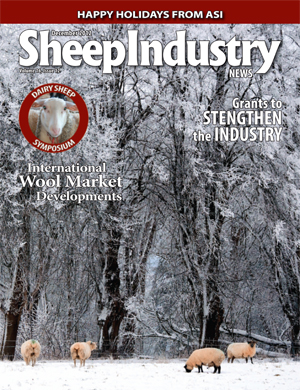
- December 2013
- President’s Notes
- Market Report
- Pfliger Represents ASI at Trade Talk
- Sheep Industry Meets With APHIS
- Wood to Feed Program Gets Most Out of Juniper Trees
- Ohio Jam Combines Lamb and Wine
- Diversity Plays Big Role in Success for National Spinning
- Peavey, Percival to Represent Producers on Lamb Board
- Grower Opens On-Ranch Processing Plant
- ALB News
- Gary Babb
- Joseph Siddoway Broadbent
Grower Opens On-Ranch Processing Plant /h3>
JAN JACKSON
Capital Press
(December 1, 2013) A new USDA-inspected processing facility, designed for grass-fed sheep, goats and cattle, has been opened in the heart of Linn County, Oregon sheep country.
Faced with a decision whether to quit focusing on meat or to build himself a processing plant, Reed Anderson chose to build. The 15,000-square-foot facility can hold 500 lambs or 70 cattle and process up to 300 animals a day.
“To make it in the sheep business, you need to go for quality or volume and we’re known the upscale branded product,” Anderson said. “The stumbling block for us was processing. Now I control the quality from the point of conception to the finished product.”
Anderson, who is the fourth generation in a five-generation sheep operation, met with his family to make the decision to build.
“We looked at grants and co-ops and the like and decided to mortgage the farm,” Anderson said.
“I wanted the building itself to look like an agriculture building and not a barn, and depending on which piece of equipment you look at depends on if it was purchased new, bought and shipped from a processing plant that closed in Chicago or was custom made for us,” he said.
The pelts are dried in an adjacent building and sent to a pelt plant in Texas.
“I followed the Temple Grandin model in the holding pens — lots of lights, curved passageways, non-slip well-drained surfaces — everything to create humane, stress-free conditions and I have security cameras patrolling the offloading areas,” he said. “People with animal experience helped me put it together and we all knew what we didn’t want.”
Geoff Latham of Nicky USA and Mike Wooley of Longs Meat Market in Eugene are among the customers that rely heavily on Anderson’s fresh lamb, and both men jumped at the first opportunity to tour the new facility.
“A state-of-the-art processing plant right here in the valley is perfect for us,” Latham said. “We both look for local ranches that grass feed and this makes us happy.”
Anderson, who is looking forward to the building phase being over, said that he has probably wanted his own processing plant all his life.
“Every time I hit a snag I would say to myself that if I had my own plant I could,…” he said. “I remember the days we just raised sheep and after all the work of keeping them away from the coyotes, they were always either too big, too small, too black, too white or it wasn’t the right time for the pelts,” Anderson said. “Today, I can raise them the way I think they ought to be raised, process them the minute I believe the time is right and get them to my customer.”
Reprinted from the Capital Press

